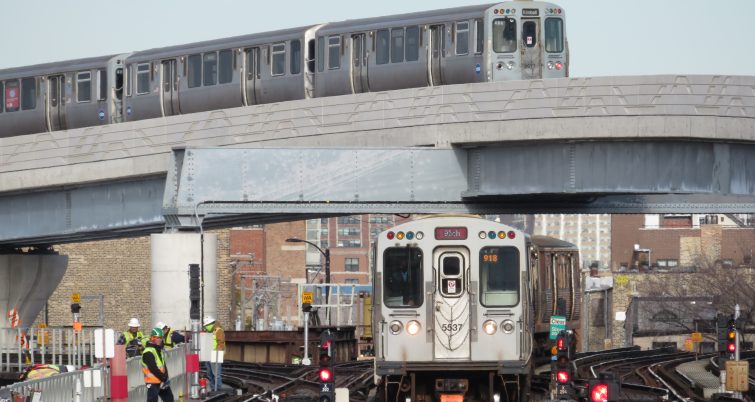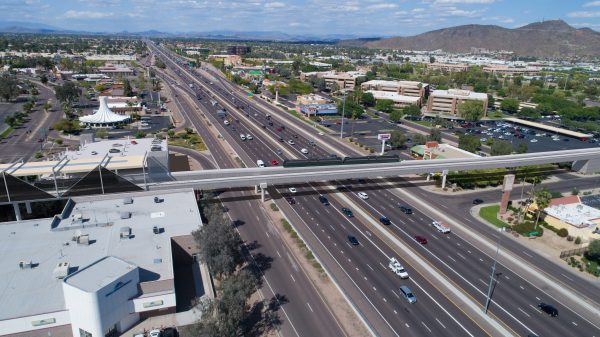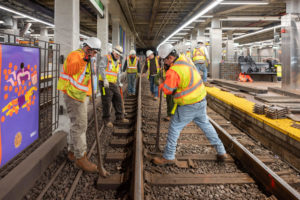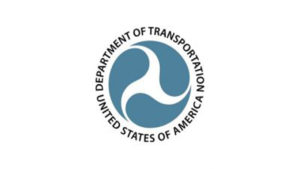Key rail projects across the U.S. make significant progress
Written by RT&S Staff
Railway Track & Structures magazine takes a closer look at four rail projects going on this year.
All projects have legs, but when there are X-rays involved it becomes a problem. Taking a closer look at a break costs more time and more money. The huge scale of rail construction make delays and cost overruns almost a foregone conclusion, but progress eventually wins in the end and today the industry is kicking up plenty of success.
In the January issue of RT&S (see Know anyone? p 11) updates were provided on some of the biggest transit projects in the U.S. This article provides progress reports on a few more critical projects.
Red and Purple Modernization Phase I
Chicago, Ill.
$2.1 billion
Status: First milestone complete
Crews began building the Red-Purple Bypass in 2019 and service started back in November. The bypass carries northbound Brown Line trains over north- and southbound Red and Purple line tracks just north of Belmont Station, and work involved replacing an antiquated rail junction built in 1907 to connect the Brown Line to the Red and Purple lines. The new bypass is the first new, permanent mainline track to be added to the Chicago Transit Authority since the Orange Line opened in 1993. Now that the bypass is complete, work will begin on demolishing, rebuilding, and realigning the 100-year-old Red and Purple line tracks between Belmont Station and W. Cornelia Avenue. The Red and Purple tracks north of Belmont are more than a century old and contain a curve that slows train speeds.
The second portion of work includes rebuilding track structures and four stations between Lawrence and Bryn Mawr Red Line stations. The project began last spring.
Milestone 2 is substantial completion of the Lawrence to Bryn Mawr project, which is expected to happen by the end of 2024. Milestone 3 involves substantial completion of the Red and Purple Line Modernization Phase 1, which should occur in 2025.
Northwest Extension Phase II
Phoenix, Ariz.
$401 million
Status: 34% complete
Phase II of the Northwest Extension will lengthen light rail west on Dunlap Avenue in Phoenix from 19th Avenue, then north on 25th Avenue and across I-17 on Mountain View Road with a terminus on the west side of the freeway near Metrocenter Mall. It involves 1.6 miles of track.
As of December 2021 two-way traffic was moved to the north side of Dunlap Avenue to accommodate utility relocations, road widening and track/station infrastructure. Construction on the Arizona Canal Diversion Channel bridge began in November 2021 and is estimated to continue through March 2022. The first phase of construction work, utility relocations, and roadway widening continues in various locations along the route. Additional bridge construction continues with work on both the east and west sides of the I-17 light-rail bridges.

Utility work is expected to be finished this summer and track and station installation will be the focus throughout the route during 2022.
Howard Street Tunnel Project
Baltimore, Md.
$466 million
Status: Preliminary design of Howard Street Tunnel Project is complete
The Howard Street Tunnel Project consists of vertical clearance improvements along CSX’s I-95 rail corridor to allow double-stack trains to travel between Baltimore, Md., and Philadelphia, Pa. The primary obstacle to double-stack service along this corridor has been the Howard Street Tunnel, a 1.7-mile-long railroad passage under the heart of Baltimore that was constructed in 1895. The Howard Street Tunnel and 21 other clearance obstructions along the route will be dealt with to allow for the double-stacking of railcars into and out of the Port of Baltimore. Bridge replacements, bridge modifications, and track lowering will happen in the state of Maryland. Track lowering will occur in Delaware and Pennsylvania.
The current tunnel is a combination of three different styles. There is a mine section, a section that was cut and covered and then a more modern section, concrete box, towards the south end.
CSX is in the process of procuring a design-build firm and plans to select one in early second quarter of 2022. Construction should start soon thereafter. The project should be complete in 2025.
“The challenge with any mainline railroad project is competing for space,” CSX Chief Engineer, Bridges, Design and Construction, Ed Sparks told RT&S. “It is a very active and important rail line so the challenge will be coordinating the sufficient windows in the operation to make constructive progress.
“That’s a busy location in our network under normal circumstances, and to have a significant construction project right in the midst of it will definitely be a challenge.
Genesee & Wyoming KYLE Railroad track work
According to Kenton Esbenshade, vice president of engineering for Genesee & Wyoming’s Western Region railroads, “there are some fairly extensive upgrades happening on G&W’s Kyle Railroad [KYLE] that runs across Kansas and into Colorado,” he told RT&S.
Last year on KYLE’s 56-mile Solomon Subdivision, engineering teams welded 10 miles. Twenty miles of rail is the plan for 2022.
On KYLE’s Concordia Subdivision, crews will upgrade jointed rail to welded rail, allowing trains to operate at 25 mph for a large portion of the 65-mile stretch between Glen Elder, Kan., and Solomon, Kan. This route connects one of KYLE’s main grain customers to an interchange with Union Pacific, and when work is completed trip time will be cut from 6.5 hours to under three hours.
Read more articles on passenger rail.





